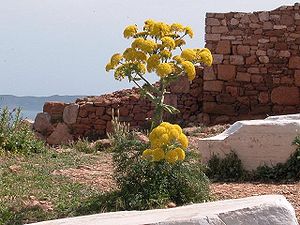Giant fennel
| Giant fennel | ||||||||||||
|---|---|---|---|---|---|---|---|---|---|---|---|---|

Giant fennel ( Ferula communis ) |
||||||||||||
| Systematics | ||||||||||||
|
||||||||||||
| Scientific name | ||||||||||||
| Ferula communis | ||||||||||||
| L. |
The Ferula communis ( Ferula communis ), also Gemeines Plug herb or Gemeines rods herb called, is a plant type from the family of the Umbelliferae (Apiaceae). In ancient Rome it was known as narthex ( Greek νάρθηξ ) or (in a presumably extinct variety) as silphium .
description
Habitus
The herbaceous perennial plant reaches heights of between 1 and 3 meters. On the thick, about 3–7 cm thick and furrowed stem there are richly branched, doldy partial inflorescences. The rather thin stems is largely a slight Mark filled that some of the few uses of the plant showed (see cultural history).
leaves
As with other umbelliferae, the leaves are finely divided and thin. The soft leaves are three to fourfold pinnate, with up to 5 cm long flat linear sections. The lower leaves have long stalks and are 30 to 60 cm tall. The upper leaves have strikingly large leaf sheaths, the leaf blade is completely reduced in the uppermost.
Inflorescence and flower
The inflorescences of the giant fennel consist of many double-gold partial inflorescences , similar to those of other umbellifers such as celery or carrots . The compound inflorescences consist of short-stalked, fruit-bearing end umbels, they are 20 to 40-rayed and surrounded by long-stemmed, sterile side umbels. The petals are yellow and 8 mm long, a covering is missing and the covering leaves fall off early.
Double achenes are formed, the two individual, elliptical, ribbed and flattened, short-winged achenes are orange-brownish.
Flowering time is from April to June.
Chromosome number
The number of chromosomes is 2n = 22.
distribution
This type of plant is common throughout the Mediterranean . It prefers calcareous soils. One can distinguish three subspecies:
- Ferula communis L. subsp. communis : It occurs in Spain, Italy, France, Corsica, Sardinia, Sicily, Croatia, Albania, Greece, Crete, in the Aegean Sea and in European and Asian Turkey.
- Ferula communis subsp. cardonae Sánchez-Cux. & M. Bernal : It only occurs in Menorca .
- Ferula communis subsp. catalaunica (C. Vicioso) Sánchez-Cux. & M. Bernal : It occurs in Portugal, Spain, France, Mallorca, Menorca and Ibiza.
ecology
The giant fennel is used by caterpillars as food, including the Corsican swallowtail ( Papilio hospiton Gunée).
Cultural history
According to legend, Prometheus is said to have used the dry stalk of a giant fennel to light it on the sun chariot of Helios and to bring people the fire that the gods wanted to withhold from them.
- ... But Iápetos ' son (= Prometheus) , the famous,
- stole this back from the all-wise Zeus for the people
- hidden in a hollow narthex, the thunderous. ( Hesiod , works and days )
The easily inflammable pulp of the stem slowly smoulders and burns without completely destroying the bark of the stem. The pulp was used as tinder and served to transport embers.
The plant was also sacred to the god of wine , Dionysus . The light yet stable stem was crowned with a pine cone. Those who had given too much wine could lean on such sticks, which were called thyrsoi , without risk of injury .
In Italy, the medieval Benandanti used the stalks of the giant fennel to fight witches .
use
In ancient Rome, the stalk was used for punishment. For the chastisement of slaves it was soaked in water and was painful, for children it was used dry (noisy but not very painful). The Latin verb ferire (to beat) and the Latin name of the plant, ferula , indicate this connection.
The stems of the giant fennel were also used for small pieces of furniture such as stools and shelves, which were made of bamboo in a similar way to those made of bamboo .
Likewise, Ferula communis was (and is partly still today) used in North Africa and especially in Sicily for the production of beehives : square frames are built from the dry stems, which are stapled together with straight rods to form approx. 1 m long tunnels. These are grouted with a mixture of cow dung and clay and, after drying, stacked in rows on top of each other.
A gum resin is extracted from the roots (Fasoy, Fasukh, Fessoukh, African ammonia gum ).
Common names
The other common German-language names exist or existed for the giant fennel : Aruten ( Tirol im Pongau , Pinzgau ), Bickwurz and Birkenwurz.
See also
literature
- Dankwart Seidel: Flowers on the Mediterranean. Determine accurately with the 3-check . BLV, Munich 2002, ISBN 3-405-16294-7 .
- Ferula communis in the endangered Red List species the IUCN 2015 Posted by: H. Rankou, A. Ouhammou, M. Taleb & G. Martin, 2014. Accessed January 24, 2018th
Individual evidence
- ↑ Ferula communis at Tropicos.org. In: IPCN Chromosome Reports . Missouri Botanical Garden, St. Louis
- ↑ a b c d R. Hand (2011): Apiaceae. : Datasheet Ferula communis In: Euro + Med Plantbase - the information resource for Euro-Mediterranean plant diversity .
- ↑ Carlo Ginzburg: benandanti I: Ricerche sulla stregoneria e sui culti agrari tra Cinquecento Seicento e. 1966, The Benandanti. Field cults and witches in the 16th and 17th centuries . Syndicate, Frankfurt a. M. 1980.
- ^ Friedrich Ruttner: Historical development of the beehive. Apimondia , Bucharest 1979, p. 17.
- ^ Georg August Pritzel , Carl Jessen : The German folk names of plants. New contribution to the German linguistic treasure. Philipp Cohen, Hannover 1882, page 151. ( online ).
Web links
- Interview with Carlo Ginzburg about his research on the Benandanti .
- Ferula communis from Useful Temperate Plants, accessed January 24, 2018.
